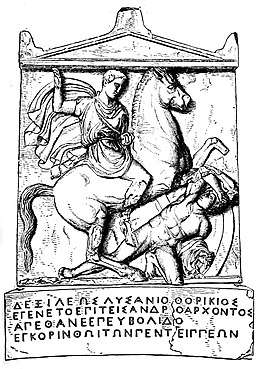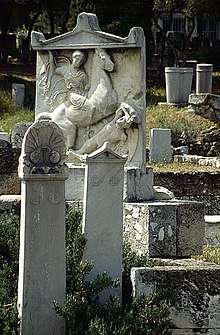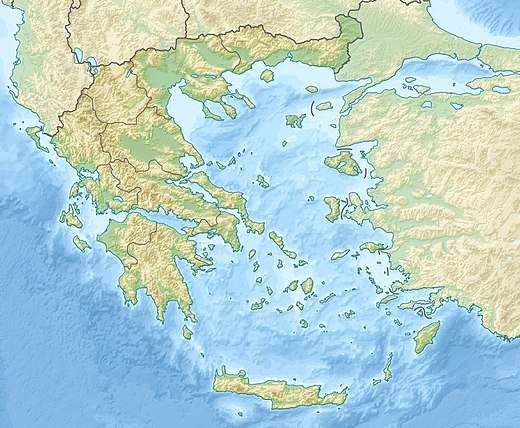Grave Stele of Dexileos
The Grave Stele of Dexileos, is the stele of the tomb of an Athenian cavalryman named Dexileos (Greek: ΔΕ![]()
| Grave Stele of Dexileos | |
|---|---|
_(4454389225).jpg) Athenian cavalryman Dexileos fighting a naked Peloponnesian hoplite in the Corinthian War.[1] Dexileos was killed in action near Corinth in the summer of 394 BC, probably in the Battle of Nemea,[1] or in a proximate engagement.[2] Grave Stele of Dexileos, 394-393 BC. | |
| Material | Pentelic marble |
| Size | 1.86 metres (6 ft 1 in) tall |
| Writing | Epitaph in Greek |
| Created | Circa 394 BC |
| Discovered | 1863 AD |
| Present location | Dipylon cemetery, Kerameikos, Athens, Greece |
Description
The stele is carved in high relief and depicts a cavalryman, Dexileos, mounted on a horse, charging a Spartan enemy, probably at the 394 BC Battle of Nemea during the Corinthian War. Dexileos is seen in his youthfulness, shown through the lack of a beard being present. He wears a chiton, chlamys, and petasos as well as krepides on his feet. His garments flow in the wind as his horse rears upwards. Dexileos has one arm up, in position to hold a spear, which has since been lost from the sculpture as it was an attachment of a different material. His torso twist forward in the frontal position while his head is in ¾ position, slanted with his gaze down towards his foe. The spear, reins, and petasos, which is a wide brimmed hat usually worn by Athenian ephebe, are all missing from the stele. Remnants of their presence are marked by stains and dowel holes in the relief where they would have been attached. Below the horse is Dexileos’s enemy, who has fallen in battle and is shielding himself from the equine with one arm covering his head. The greek enemy is seen in the frontal position with his head up towards Dexileos.[4] The enemy is also depicted completely nude, representing his vulnerability as well as his worthiness as an opponent.[5] The inscription below the relief says:[3]
Dexileos son of Lysanias of Thorikos.
He was born in the archonship of Teisandros (i.e. year 414/3);
he died in that of Euboulides (i.e. year 394/3),at Corinth, one of the five cavalrymen.
— Epitaph of Dexileos, cavalryman killed in Corinthian war (394 BC)[6]
This not only gives an exact date of Dexileos’s lifespan but also describes his death in battle at Corinth. The entire stele relief scene is bordered on top with a pediment adorned with acroteria, which gives it a religious aspect with reference to naiskos, a small temple in the classical order.[4]

Context
The Dexileos stele reflects Athens during a time of chaos and disorder. Following the Athenian loss of the Peloponnesian War, Athenian democracy was finally restored after the ruling of Thirty Tyrants. Athens was also facing a war with Sparta at this time, the Corinthian War. Dexileos was a young cavalryman who died at the age of 20, which can be seen through the inscription that reveals his lifespan. Dexileos would have been an ephebe, going through his rite of passage to become a full, democratic citizen, like other Athenian men. This process included serving in the military for three years. This stele shares characteristics of two distinct ideologies in the classical period relating to death in battle; One being a very individualistic depiction glorifying the deceased and the other being an inclusion of aristocracy within Athenian democracy and depicting death as a sacrifice for the state. While this monument depicts wealthy Dexileos in triumph, bringing pride to his family, it also shows how he is part of the Athenian community, making a sacrifice of life for his people. [4] [7]
Location

The Dexileos Stele is one of three monuments honoring an Athenian warrior in the Dipylon cemetery. One other monument, the Polyandron, honors all those soldiers who died for the city within a certain year, including the death of Dexileos. All these soldiers remains, including those of the elite cavalry status as well as less wealthy foot soldiers, were mixed together, burned, and placed in the Demosion Sema for burial. This ritual equated all Athenians after death to create a complete, whole democracy. The other monument honored all fallen cavalrymen, listing eleven including Dexileos in total. This monument preserved the sacrifices of those cavalrymen to democracy.[4]
Funerary crown
_2017_(detail).jpg)
Another monument was discovered, dedicated to five Athenian cavalrymen including Dexileos. Only the crown of the public funerary monument remains, now in Athens National Archaeological Museum. The monument, in pentelic marble, was found west of Athens, in the area of the Demosion Sema. According to the inscription on the epistyle, the monument was erected in honour of the Athenian riders who fell in the Battle of Corinth (394) and the Battle of Coronea (394 BC). The list of the fallen includes the name of Dexileos, the young man who was also commemorated by means of a private relief stele that came to light in the ancient cemetery of the Kerameikos.[8]
See also
References
- Hutchinson, Godfrey (2014). Sparta: Unfit for Empire. Frontline Books. p. 43. ISBN 9781848322226.
- "IGII2 6217 Epitaph of Dexileos, cavalryman killed in Corinthian war (394 BC)". www.atticinscriptions.com.
- "Kerameikos P 1130 (Sculpture)". www.perseus.tufts.edu.
- "The Dexileos Stele: A Study of Aristocracy and Democracy in Greek Art". Ancient History Encyclopedia.
- "Grave Stele of Dexileos | Museum of Classical Archaeology Databases". museum.classics.cam.ac.uk.
- "IGII2 6217 Epitaph of Dexileos, cavalryman killed in the Corinthian war (394 BC)". www.atticinscriptions.com.
- T., Neer, Richard (2012). Greek art and archaeology : a new history, c. 2500-c. 150 BCE. New York. ISBN 9780500288771. OCLC 745332893.
- Hurwit, Jeffrey M. (2007). "The Problem with Dexileos: Heroic and Other Nudities in Greek Art". American Journal of Archaeology. American Journal of Archaeology Vol. 111, No. 1. 111 (1): 35–60. doi:10.3764/aja.111.1.35. JSTOR 40024580.
